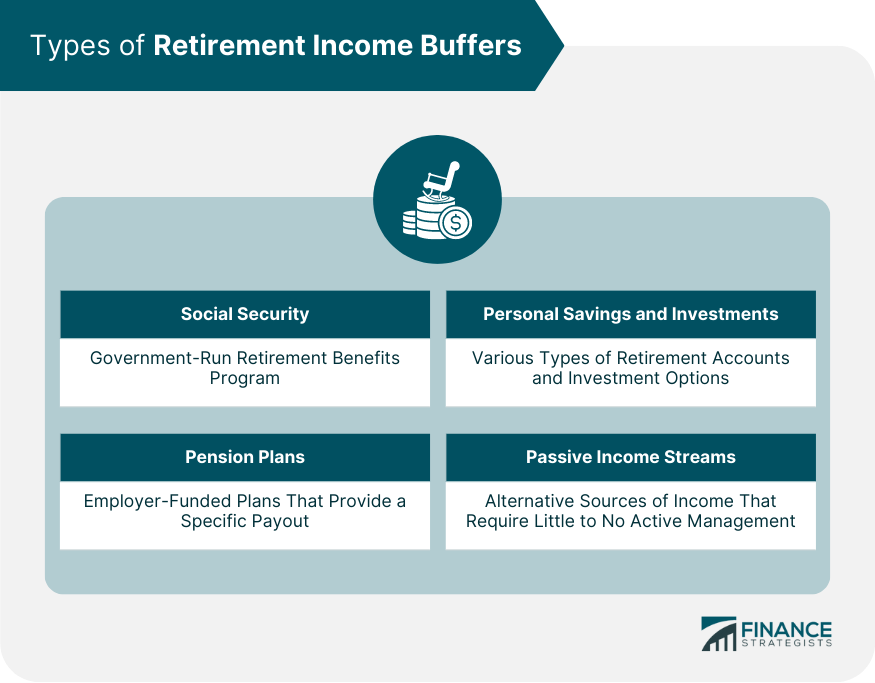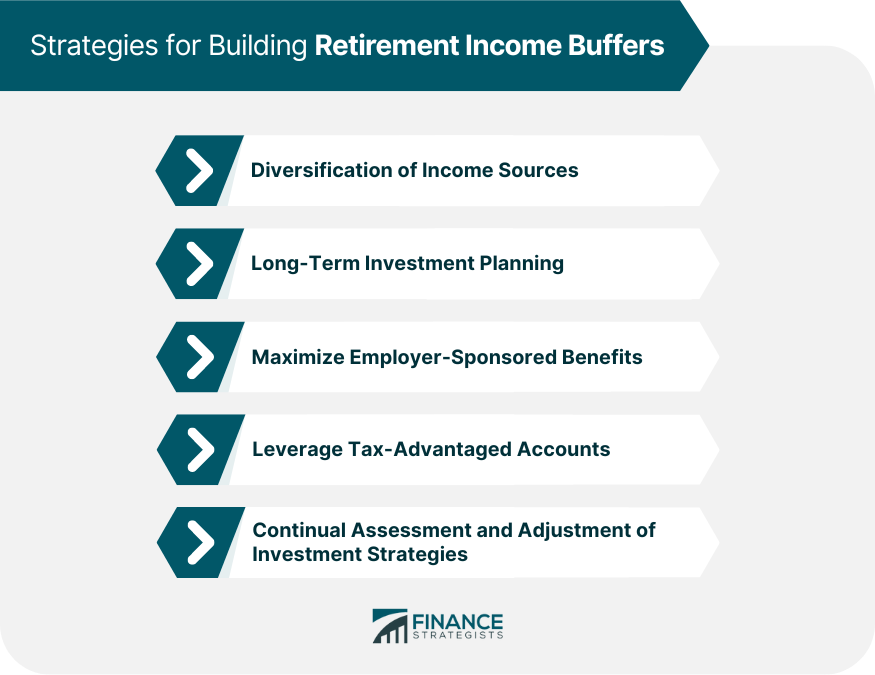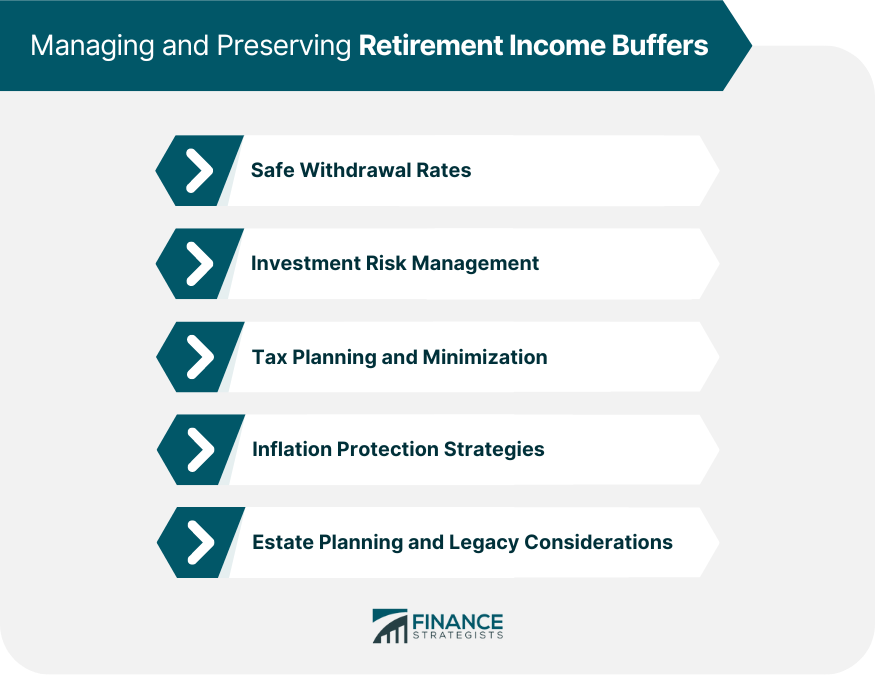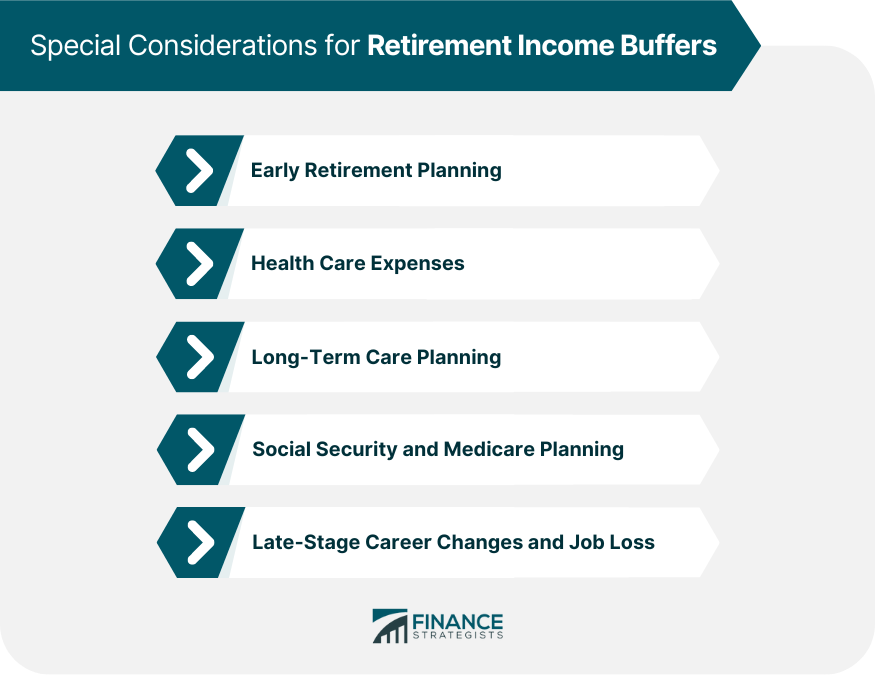Retirement income buffer refers to the financial cushion or reserve that retirees set aside to ensure a stable and sustainable stream of income during their retirement years. It is typically a savings or investment account that retirees can draw from to cover unexpected expenses or fluctuations in their regular retirement income. Social Security is a government-run retirement benefits program that provides a steady income to eligible retirees. To qualify for Social Security benefits, individuals must have accumulated a specific number of work credits over their working life. The Social Security Administration calculates benefit amounts based on the retiree's lifetime earnings and age at retirement. Retirees can start receiving benefits as early as age 62, with the full retirement age ranging between 65 and 67, depending on the year of birth. To maximize Social Security benefits, retirees can delay claiming them, resulting in higher monthly payments. Additionally, strategies like "file and suspend" or "restricted application" can also help increase overall benefits. Defined benefit pension plans provide retirees with a predetermined monthly income based on factors such as salary, years of service, and age at retirement. These plans are primarily employer-funded and guarantee a specific payout. Defined contribution plans, such as 401(k) and 403(b), allow employees and employers to contribute to an individual's retirement account. The final retirement income depends on the amount contributed and the investment returns over time. Some employers offer hybrid pension plans, which combine features of both defined benefit and defined contribution plans, providing retirees with a blend of guaranteed income and investment growth. IRAs are tax-advantaged retirement savings accounts that individuals can open to supplement their retirement income. There are two main types – Traditional IRAs and Roth IRAs, each with unique tax benefits and withdrawal rules. These employer-sponsored retirement plans allow employees to contribute pre-tax dollars to retirement accounts, often with an employer match. Funds grow tax-deferred, and withdrawals during retirement are taxed as ordinary income. Individuals can invest in stocks, bonds, mutual funds, and other securities through taxable brokerage accounts to build retirement income buffers. While these accounts do not offer tax advantages, they provide flexibility in terms of investment choices and withdrawal rules. Real estate investments, such as rental properties or Real Estate Investment Trusts (REITs), can generate passive income and long-term capital appreciation to supplement retirement income. Annuities are insurance products that provide a guaranteed stream of income during retirement in exchange for an upfront premium payment. There are various types of annuities, each with different payout options and features. Investing in rental properties can generate a steady stream of passive income during retirement, especially if the properties are well-maintained and located in desirable areas. Dividend stocks are shares in companies that pay regular dividends to shareholders. Investing in a diverse portfolio of dividend-paying stocks can provide a reliable source of income during retirement. Investing in peer-to-peer lending platforms allows individuals to lend money to borrowers, earning interest income in return. This alternative investment can be a source of passive income during retirement. Royalties from creative works, such as books, music, or patents, can provide a passive income stream during retirement. This source of income depends on the success and popularity of the creative work and may require active marketing and promotion efforts. Owning a business or having a stake in a profitable partnership can provide passive income during retirement. Proper management, delegation, and succession planning are crucial to ensure the continued success of the business. Creating a diversified portfolio of income sources is essential for minimizing risk and ensuring financial stability during retirement. This strategy involves investing in various asset classes, such as stocks, bonds, real estate, and alternative investments. Developing a long-term investment plan that aligns with individual retirement goals is crucial. This plan should consider factors such as risk tolerance, time horizon, and desired retirement lifestyle. Taking full advantage of employer-sponsored benefits, such as 401(k) or 403(b) plans and pension plans, can significantly increase retirement income buffers. Employees should aim to contribute at least enough to receive the maximum employer match. Using tax-advantaged accounts, such as IRAs, 401(k)s, and 403(b)s, can help grow retirement savings more efficiently by deferring taxes on investment gains or allowing for tax-free withdrawals in retirement. Regularly reviewing and adjusting investment strategies is essential for keeping retirement income buffers on track. Changes in personal circumstances, financial markets, and tax laws may necessitate adjustments to investment portfolios and retirement plans. Determining a safe withdrawal rate from retirement accounts is crucial for ensuring that savings last throughout retirement. A commonly used rule of thumb is the 4% rule, which suggests withdrawing 4% of the initial portfolio value annually, adjusted for inflation. Managing investment risk during retirement is essential to preserve income buffers. Retirees should maintain a diversified portfolio, gradually shifting from higher-risk investments to more conservative options as they age. Effective tax planning can help minimize the tax burden on retirement income. Strategies may include leveraging tax-advantaged accounts, tax-efficient withdrawals, and tax-loss harvesting. Inflation can erode the purchasing power of retirement income buffers. Investing in assets that have historically outpaced inflation, such as stocks and real estate, can help protect against this risk. Proper estate planning ensures that an individual's assets are distributed according to their wishes and minimizes potential tax burdens for beneficiaries. This process may involve creating a will, setting up trusts, and designating beneficiaries for retirement accounts and insurance policies. Individuals considering early retirement must plan and save aggressively to ensure they have sufficient income buffers to support a potentially longer retirement period. Healthcare costs can be a significant expense during retirement, and planning for these expenses is crucial. Strategies may include contributing to a Health Savings Account (HSA), purchasing long-term care insurance, or choosing appropriate Medicare plans. As life expectancy increases, the likelihood of needing long-term care services also rises. Planning for potential long-term care needs can help protect retirement income buffers from unexpected expenses. Understanding the intricacies of Social Security and Medicare is vital for maximizing benefits and making informed decisions about when to claim benefits and enroll in various Medicare programs. Late-stage career changes or unexpected job loss can significantly impact retirement income buffers. Strategies to mitigate this risk include updating skills, networking, and considering part-time or consulting work to bridge the gap until full retirement. Building and maintaining a diverse range of retirement income buffers is crucial for ensuring a financially secure and comfortable retirement. By investing in multiple sources, such as Social Security, pension plans, personal savings, investments, and passive income streams, individuals can create a stable income throughout their retirement years. It is important to employ strategies like diversification, long-term investment planning, maximizing employer-sponsored benefits, and leveraging tax-advantaged accounts to optimize these income buffers. Additionally, individuals should be aware of special considerations such as early retirement planning, health care expenses, long-term care planning, and late-stage career changes to effectively navigate challenges and uncertainties. Through careful planning, continuous assessment, and timely adjustments, individuals can safeguard their financial stability and enjoy a worry-free retirement.What Is Retirement Income Buffer?
Types of Retirement Income Buffers

Social Security
Pension Plans
Defined Benefit Plans
Defined Contribution Plans
Hybrid Plans
Personal Savings and Investments
Individual Retirement Accounts (IRAs)
401(k) and 403(b) Plans
Brokerage Accounts
Real Estate Investments
Annuities
Passive Income Streams
Rental Properties
Dividend Stocks
Peer-to-Peer Lending
Royalties from Creative Works
Business Ownership and Partnerships
Strategies for Building Retirement Income Buffers
Diversification of Income Sources
Long-Term Investment Planning
Maximizing Employer-Sponsored Benefits
Leveraging Tax-Advantaged Accounts
Continual Assessment and Adjustment of Investment Strategies

Managing and Preserving Retirement Income Buffers
Safe Withdrawal Rates
Investment Risk Management
Tax Planning and Minimization
Inflation Protection Strategies
Estate Planning and Legacy Considerations

Special Considerations for Retirement Income Buffers
Early Retirement Planning
Health Care Expenses
Long-Term Care Planning
Social Security and Medicare Planning
Late-Stage Career Changes and Job Loss

Conclusion
Retirement Income Buffer FAQs
Retirement income buffers are the various sources of income that can be tapped into during retirement to ensure financial stability. They are essential for maintaining a comfortable and worry-free retirement by providing a diversified and steady income stream.
To create retirement income buffers, you can invest in Social Security, pension plans, personal savings, and investments like IRAs, 401(k)s, and real estate, as well as establish passive income streams from rental properties, dividend stocks, peer-to-peer lending, royalties, and business ownership.
Strategies for building and maintaining retirement income buffers include diversifying income sources, implementing long-term investment planning, maximizing employer-sponsored benefits, leveraging tax-advantaged accounts, and continually assessing and adjusting investment strategies.
You can manage and preserve your retirement income buffers by determining a safe withdrawal rate, managing investment risk, planning for taxes and inflation, and considering estate planning and legacy considerations.
Special considerations for retirement income buffers include early retirement planning, accounting for health care expenses, long-term care planning, understanding Social Security and Medicare, and navigating late-stage career changes or job loss. Being prepared for these scenarios can help protect your retirement income buffers and ensure a financially secure retirement.
True Tamplin is a published author, public speaker, CEO of UpDigital, and founder of Finance Strategists.
True is a Certified Educator in Personal Finance (CEPF®), author of The Handy Financial Ratios Guide, a member of the Society for Advancing Business Editing and Writing, contributes to his financial education site, Finance Strategists, and has spoken to various financial communities such as the CFA Institute, as well as university students like his Alma mater, Biola University, where he received a bachelor of science in business and data analytics.
To learn more about True, visit his personal website or view his author profiles on Amazon, Nasdaq and Forbes.













